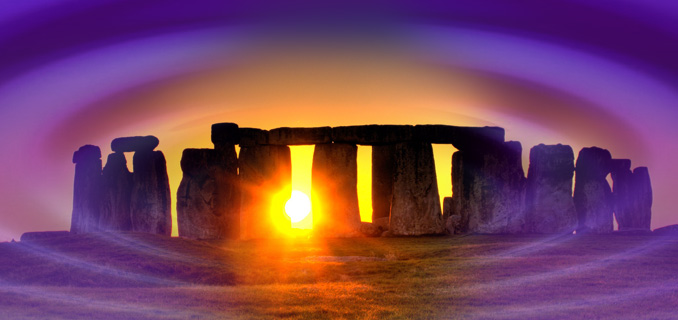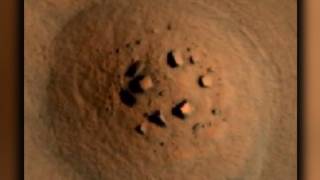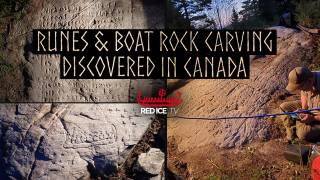Stonehenge ’was a prehistoric centre for rock music’: Stones sound like bells, drums, and gongs when played
Source: alternews.co.uk

Stonehenge may have been built by Stone Age man as a prehistoric centre for rock music, a new study has claimed.
According to experts from London’s Royal College of Art, some of the stones sound like bells, drums, and gongs when they are ’played’ - or hit with hammers.
Archaeologists, who have pondered why stone age man transported Bluestones 200 miles from Mynydd Y Preseli in Pembrokshire, South West Wales to Stonehenge, believe this discovery could hold the key.
The ’sonic rocks’ could have been specifically picked because of their ’acoustic energy’ which means they can make a variety of noises ranging from metallic to wooden sounding, in a number of notes.
Research published today in the Journal of Time & Mind reveals the surprising new role for the Preseli Bluestones which make up the famous monument, and which were sourced from the Pembrokeshire landscape on and around the Carn Menyn ridge, on Mynydd Preseli, South-West Wales.
Bluestones were used in the village of Maenclochog - meaning bell or ringing stones - until the 18th century.
A significant percentage of the rocks on Carn Menyn produce metallic sounds - like bells, gongs or tin drums - when struck with small hammerstones. Such sonic or musical rocks are referred to as ’ringing rocks’ or ’lithophones’.
The Landscape & Perception project drew upon the comments of the early ’rock gong’ pioneer, Bernard Fagg, a one-time curator of the Pitt Rivers Museum, in Oxford.
He suspected there were ringing rocks on or around Preseli and suggested that this was the reason why so many Neolithic monuments exist in the region – with the sounds making the landscape sacred to Stone Age people.
English Heritage allowed archaeologists from Bournemouth and Bristol universities to acoustically test the bluestones at Stonehenge, effectively playing them like a huge xylophone.
To the researchers’ surprise, several were found to make distinctive if muted sounds, with several of the rocks showing evidence of having already been struck.
The stones make different pitched noises in different places and different stones make different noises - ranging from a metallic to a wooden sound.
The investigators believe that this could have been the prime reason behind the otherwise inexplicable transport of these stones nearly 200 miles from Preseli to Salisbury Plain.
There were plentiful local rocks from which Stonehenge could have been built, yet the bluestones were considered special.
The principal investigators for the Landscape & Perception project are Jon Wozencroft and Paul Devereux. Wozencroft is a senior lecturer at the RCA and the founding director of the musical publishing company, Touch.
Jon Wozencroft told MailOnline it was ’amazing’ to find that the stones used in the monument make the noises that the researchers hoped for.
’It was a really magical discovery and refreshing to come across a phenomenon you can’t explain,’ he said.
The researchers have looked into geological reasons as to why some rocks make noise and others do not and one theory is that the amount of silica in the rocks could explain why in the future.
’Walking around Mynydd Y Presel you can’t tell which stones will make sounds by sight, but in time you get a sort of intuition by the way they are positioned,’ he said.
The researchers had feared the musical magic of the stones at Stonehenge might have been damaged as some of them were set in concrete in the 1950s to try and preserve the monument and the embedding of the stones damages the reverberation.
Mr Wozencroft said ’you don’t get the acoustic bounce’ but when he struck the stones gently in the experiment, they did resonate, although some of the sonic potential has been suffocated.
[...]
Read the full article at: alternews.co.uk
READ: Stonehenge design was ’inspired by sounds’
Tune into Red Ice Radio:
James Swagger - Hour 1 - The Newgrange Sirius Mystery
Richard Merrick - The Venus Blueprint, Psychoacoustical Temples & Entheogenic Communion
Hugh Newman - Earth Grids, Megaliths, Sacred Sites, Fertility Technology & Indigo Children
Hugh Newman - Megalithomania(cs) & Megalithic Mesoamerica
Hugh Newman - Megalithic Sites of New England, Global Earth Energies & Lake Titicaca
James Furia - Geomusic
Alex Putney - Human Resonance, Sacred Sites, Standing Waves & DNA Illumination






















